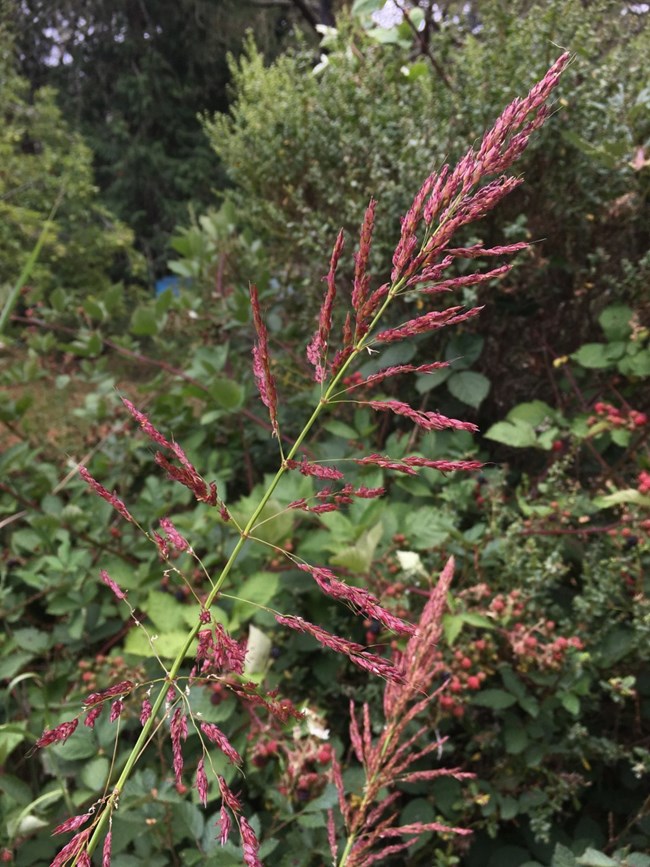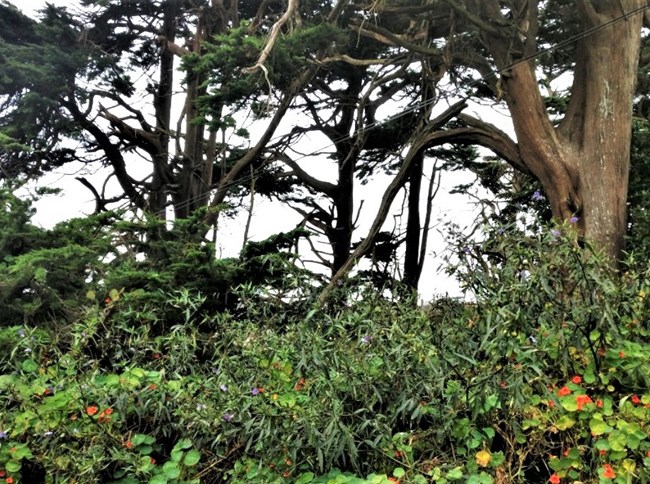Last updated: July 8, 2025
Article
Early Detection News - September 2018
September Surveys
The Invasive Species Early Detection Team (ISED) conducted September surveys at Point Reyes National Seashore and Golden Gate National Recreation Area North District. Noteworthy detections this month included reed canary grass, Johnson grass, and horehound.
Noteworthy Early Detections

NPS / Eric Wrubel
Reed Canary Grass
(Phalaris arundinacea)
In early September, ISED conducted targeted surveys for reed canary grass near Schooner Bay. These surveys were initiated based on reports from Point Reyes staff of populations in the vicinity of the historic Drakes Bay Oyster Farm. We mapped an extensive stand of reed canary grass which dominated almost seven acres, and also found several satellite populations along the oyster farm access road. The large stand was almost certainly planted as pasture at some point in the past, and is still actively grazed.
Reed canary grass is native to North America and occurs throughout the United States in wet sites along streams and in grasslands and woodlands. However, European cultivars have been introduced that hybridize with native populations, and show increased vigor and invasiveness. There is concern that these hybrids may swamp out native genotypes. Introduced strains of reed canary grass invade wetlands and riparian areas and can cause a decrease in plant diversity. Reed canary grass is a large, fast-growing plant which produces extensive lateral growth in both its leaves and roots, allowing it to effectively compete for sunlight and nutrients even in poor conditions.
While reed canary grass is considered native to parts of California, it has most likely been recently introduced in Marin County. There are no historic collections or records of this species in the county, and recent observations are from disturbed sites, where it appears to have been deliberately planted.
Resources:
DiTomaso, J., Healy, E. A. 2003. Aquatic and riparian weeds of the west. UCANR.
USDA Fire Effects Information System

NPS / Eric Wrubel
Johnson grass
(Sorghum halepense)
In late August, ISED re-assessed a small population of Johnson grass along Sir Francis Drake Blvd. at the SPAWN headquarters. This is the only known location of Johnson grass in Golden Gate or Point Reyes, and is therefore a high priority for eradication.
Johnson grass is a large, clumping perennial grass with a purple panicle and vigorous, coarse rhizomes. A plant with a worldwide range, it is thought to be native to the Mediterranean region, and is considered to be one of the 10 most noxious weeds in the world. It prefers disturbed soils, and in California it is primarily an agricultural weed. The extensive rhizome system and fast growing nature of Johnson grass enables this plant form dense stands that displace other plants. The roots extend a foot or more underground, giving it a competitive advantage for water extraction. The California Department of Food and Agriculture classifies it as a C-listed noxious weed.
Johnson grass is a warm-season grass, meaning it is better adapted to growth and establishment in warmer climates than that of coastal Marin County. Nevertheless, eradication of this population is prudent given that the climate is projected to become warmer. Please let us know if you have information on other occurrences of Johnson grass in Point Reyes or Golden Gate.
Resources:
University of California Integrated Pest Management Program
Bugwood
USDA Fire Effects Information System

NPS / Steven Cognac
Horehound
(Marrubium vulgare)
In September, ISED mapped and removed the only known population of horehound in the Golden Gate North District and Point Reyes, on a decommissioned road north of the McCurdy trailhead. The only other horehound records in Golden Gate were recorded and removed earlier this year by the Habitat Restoration Team at the Miwok Livery Stables in Tennessee Valley.
Horehound is a subshrub in the mint family, with wrinkly opposite leaves covered in white wooly hairs, and whorls of small white flowers. The seeds are spread by dry burrs which can stick to clothing. Mature plants can produce over 20,000 seeds each year. Seeds are thought to be able to survive in soil for 7-10 years. It tends to grow in disturbed sites and in overgrazed pastures, as horehound has a bitter taste which livestock avoid. Once established, it can form dense stands in annual grasslands. CAL-IPC describes Marrubium vulgare as having limited invasiveness.
Please let us know if you have information on other occurrences of horehound in Point Reyes or Golden Gate.
Resources:
Di Tomaso et al. 2013. Weed control in natural areas in the western United States. WIRC.
Invasive Species Compendium
September 2018 Survey Results
Click on a point in the map below to view additional details about a specific record. This month's ISED records may also be viewed in an interactive map at the Calflora Observation Hotline. Navigate to the Help Site for assistance using the Observation Hotline.
